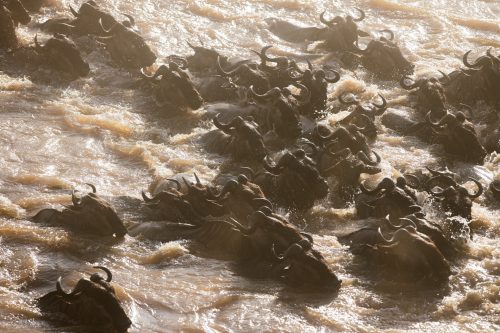Contrary to popular belief, the Great Migration isn’t a singular event but rather a year-long trek. The mega-herds make a clockwise, round-trip journey of around 600km between the Maasai Mara in Kenya in the north and the southern Serengeti plains in Tanzania, with their travel schedule guided by the seasons and rainfall patterns.
Most often, the dramatic river crossing scenes that happen in the Maasai Mara National Reserve are etched into people’s minds. These tend to happen towards the end of July and into August – although, like many things in nature, it is completely unpredictable and can change dramatically depending on the whims of the wildebeest. The mega herds of wildebeest, zebra, and topi will stretch as far as the eye can see across the Mara Triangle, offering incredible game viewing as you crisscross the Reserve from July into early October.

Although each year’s spectacle varies from one to the next, particularly when it comes to the timing and size of the mega herds, there are some constants you can expect time and time again. Drama and excitement by the bucketload as hundreds of thousands of wildebeest and zebra plunge into the jaws of the monster-sized crocodiles in the Mara River; for those that make it to the other side, a journey across the grassy plains of the Mara and into the gaze of the predators that await.
Angama guests have a front-row seat as it only takes about 45 minutes from the lodge to get to the Main Crossing site – there are about 10 sites in total. The crossings happen mostly at midday, but you must leave early to get a prime position along the banks for the best viewing. We recommend having your guide pack a picnic breakfast and lunch for a full-day safari to avoid missing any of the action.
You can sometimes wait hours to witness a crossing. Still, there is always something to observe — hippos and crocs in the water, opportunistic lions on the banks, riverine birds and sometimes elephant families crossing from one side to another. You wouldn’t be the first to catch a siesta in the safari vehicle, either. But there is something wonderful about being in nature with no cellphone signal or timetable.
It’s the busiest time of year as people come from all over the world to witness the Great Migration. Many guests stay in the Northern conservancies (they must drive 2+ hours to reach the crossing points in the Mara Triangle), some will be at lodges closer to Angama as well as lodges in the Greater Reserve, plus the self-drive visitors and tour companies from Nairobi. Thankfully, Angama guests enter as soon as the Reserve opens at dawn and are among the first vehicles at a crossing point.
It can be a long time to wait; children often bring books and things to do. They will nap, too, of course. But it is an unforgettable, once-in-a-lifetime spectacle. The sights and sounds can be frightening, as many animals perish leaping from the banks, while others are taken by crocodiles in the water, and those who make it across may be ambushed by big cats lying in wait. Booking a private safari vehicle is recommended for families travelling with children at this time of year, as it allows you to plan your safari around the children's needs.
There is another, gentler, more exclusive way to experience the Mara at this time of the year. With most visitors focusing on the river crossings, it leaves the vast majority of the wildlife-packed Triangle yours to enjoy without another soul in sight. Exploring the inselbergs (a formation of large hills) down near the Tanzanian border, home to a large pride of lions and some of the best cheetah viewing in the Mara, is the best way to spend a migration day surrounded by the thronging herds of millions of grazing herbivores. In the forests along the escarpment, elephants are known to stand on their hind legs looking for fruit in the trees.
You could even escape the chaos and float over the Great Migration in a hot-air balloon — not only an incredible experience, but it will allow you to see the spectacle from a different angle.
Tucked away in private sites deep in the Mara, guests staying at Angama Safari Camp have the mega herds on their doorstep. From this light footprint camp, it’s just a short drive to various crossing sites. Staying inside the Reserve means you can be the first to take a prime position in the morning and the last to leave at the end of the day. This is true wilderness camping, capturing the spirit of the Golden Age of safaris without sacrificing any of the comforts of 21st-century camping. Experience the thrill of having only canvas between you, the Mara, and the mega herds of the Great Migration.
At certain times of the year, the mega herds of hundreds of thousands of wildebeest congregate right below Angama Mara, making it the best vantage point to take in the true scale of the Great Migration. High above the Maasai Mara, you are far enough from the busyness below but close enough to get to the Main Crossing site in under an hour, and many others not much further away. With breathtaking views and elegant design, this is the perfect place to experience the Great Migration in style.
Filed under: Stories From The Mara
Subscribe for Weekly Stories
Comments (0):

Weddings in the Mara